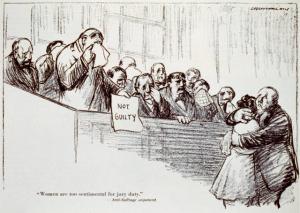The Anti-Suffragists

Following Seneca Falls there were significant divisions amongst suffragists, notably over the 15th Amendment which excluded women from voting and the use of racially divisive tactics by the National Woman Suffrage Association. In addition, there were multifaceted and nuanced ways in which suffragists were challenged, both by men and women, in their efforts to win the ballot. In this lesson, students will examine suffrage not just as an issue colored by gender, but by immigration status, race, and myriad other factors based on a close read of primary sources produced by those opposed to suffrage. This lesson will serve as an introduction to the concept of intersectionality and used as a lens to understand the world.
One to two 45 minute class periods
1. Students will create and test their own hypotheses for why some Americans opposed the 19th Amendment.
2. Students, based on their close examination of primary sources, will determine why some Americans opposed the 19th Amendment
3. Students will produce a short response, based on what they have learned in class, to explain why opposition to the 19th Amendment existed, and assess the validity of their arguments.
Students should be introduced to female suffragist leaders, their arguments for suffrage, and the efforts of NAWSA (National American Woman Suffrage Association). Students should also be familiar with the significance of Seneca Falls and the divisions within the suffrage movement.
- Primary Sources
- Petition from the Women Voters Anti-Suffrage Party of New York
- Letter to Congress from the Cambridge Branch of the Massachusetts Anti-Suffrage Association
- Letter Regarding the Federal Amendment from Ellen F. Vanderbilt
- Pamphlet Opposing Women’s Suffrage Distributed in Tennessee
- Jury Duty Political Cartoon
- Other sources found in pgs 7 and 8 in pdf
- Graphic Organizer (pg 9)
- Lesson plan pdf
- Do Now: Create a hypothesis! Why did people, including women, oppose suffrage for women?
- Class share out: Students will verbally respond to the Do Now. Expected responses include apathy for the cause, sexism, and the cult of domesticity.
- Inform students that they are going to test their hypothesis today by closely examining primary sources created by Anti-Suffragists.
- Students will complete graphic organizer (included) as they examine primary sources. Teacher should circulate, ask students what they think about primary sources and observe general reaction. The sources include a wide-range of opinions and are accessible for most groups of students.
- Class Discussion based on student work. Potential discussion questions are included below
- Why did people oppose women’s suffrage?
- What were the push and pull factors which made the decision to support or oppose suffrage difficult for women in particular? (Teacher can introduce intersectionality and explain that the decision to support or oppose is not based solely on gender)
- Which arguments for the anti-suffragists do you find compelling, if any?
- Do we still find these arguments or rhetoric about the role of women or other groups today? If so, where?
Based on what you learned today in your exploration of primary sources regarding opponents to suffrage as well as class discussion, juxtapose your hypotheses with what we have learned. What is similar? What is different? How does this relate to intersectionality?
You will incorporate one 19th or 20th century anti-suffrage song or political cartoon into your response. I recommend using the Library of Congress or National Archives for cartoons, and YouTube for music. Generally, a Google search can be fruitful as well, as long as you consider the reliability of your sources.
D2.His.4.9-12.
Analyze complex and interacting factors that influenced the perspectives of people during different historical eras.
D2.His.1.9-12
Evaluate how historical events and developments were shaped by unique circumstances of time and place as well as broader historical contexts.
CCSS.ELA-LITERACY.RH.11-12.1
Cite specific textual evidence to support analysis of primary and secondary sources, connecting insights gained from specific details to an understanding of the text as a whole.
CCSS.ELA-LITERACY.RH.11-12.2
Determine the central ideas or information of a primary or secondary source; provide an accurate summary that makes clear the relationships among the key details and ideas.
